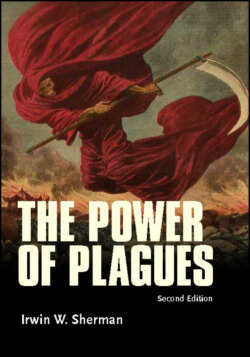Читать книгу The Power of Plagues - Irwin W. Sherman - Страница 42
Finding the Killer
ОглавлениеAs plague raged through medieval Europe, it became increasingly apparent that this disease was contagious. Even if Fracastoro’s idea of “seeds of contagion” was accepted, however, at this time there would still be no means to identify precisely the causative agent. Identifying the “seed” would not only require a technological innovation; it would also require a change in the concept of infectious (contagious) diseases. Three centuries after Fracastoro’s theory of contagion, the concept that disease could result from the invasion of the body by microbes or germs—the germ theory of disease—was established. And with a 17th-century technological innovation, the microscope, it was actually possible for humans to see germs! Two schools of thought, one in France under the leadership of Louis Pasteur (1882-1895) and the other in Germany, led by Robert Koch (1843-1910), were responsible for firmly grounding the germ theory, and for all of their lives these two microbe hunters remained fierce competitors (see p. 418).
As plague ravaged China during the third pandemic, Pasteur dispatched Alexandre Yersin (1863-1943), a Swiss-born member of the French medical colonial corps, to Hong Kong to study and attempt to isolate the germ of plague. Yersin arrived when the epidemic was in full force and was given a small table in a dark corridor next to a patients’ room, where he could leave his microscope, notebook, stains, pipettes, and a few cages with guinea pigs, mice, and rats. At first Yersin was not permitted access to the morgue, but through connivance and bribery he was finally able to visit the morgue for a few minutes to examine a sailor who had just died from plague. Yersin punctured the bubo on the dead soldier’s thigh (Fig. 4.6A) with a sterile needle and removed some fluid; he then examined the fluid under the microscope, inoculated a few guinea pigs, and sent the remainder to the Pasteur Institute in Paris. On June 24, 1894, he wrote Pasteur that the fluid was full of rod-shaped bacilli (Fig. 4.6B) that stained poorly with Gram stain; i.e., they were Gram negative. (Gram stain consists of a tincture of crystal violet. After bacteria are killed and washed, some lose the dye whereas others retain the purple color; the former are called Gram-negative and the latter Gram-positive bacilli.) Yersin also wrote: “without question this is the microbe of plague.” A few days later Yersin found that the guinea pigs he had injected with the fluid that he had aspirated from the bubo had died, and that their bodies swarmed with the same bacilli. Yersin was intrigued by the large number of dead rats in the streets of Hong Kong, as well as in the hospital corridors and the morgue. When he examined some of these dead rats, he found the same bacilli to be present. He correctly concluded that plague infects both rats and humans. At about the same time, Koch, convinced that plague was caused by a microbe, sent his associate Shibasaburo Kitasato and a large number of assistants as well as abundant equipment to find the plague germ. Kitasato did culture a bacterium from the finger of a sailor who had died from plague, but it was Gram positive. Further, Kitasato was never able to prove that this bacillus could produce plague in humans or other animals. Bubonic plague, caused by a rod-shaped, Gram-negative bacterium, was named Yersinia pestis after its discoverer, Alexandre Yersin (although Pasteurella pestis was the name used before 1970).
Figure 4.6 A. Bubo of bubonic plague (courtesy of CDC, 1993) and B. the causative agent, Yersinia pestis, stained and seen with light microscope (courtesy CDC)
